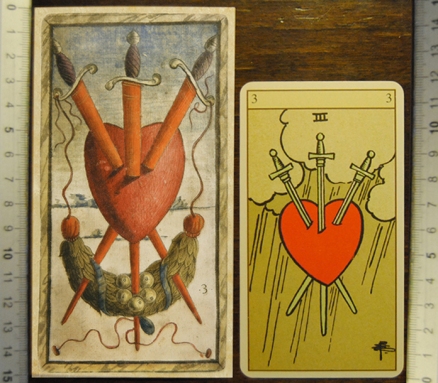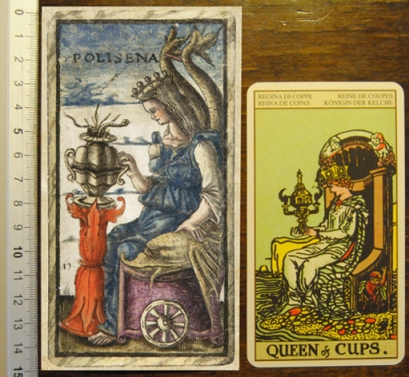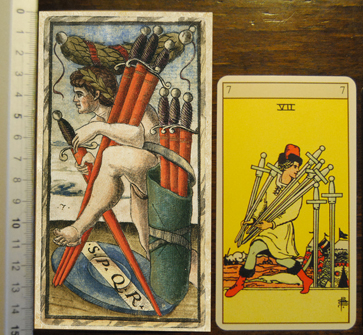In 1907 the Busca-Serbelloni family sent from Milano to British Museum the black and white photographs of the complete Sola-Busca Tarot deck, perhaps at the request of the same Museum.
Shortly thereafter, these photographs were placed on exhibit at the British Museum in London, displayed next to the 23 original engravings acquired by the Museum in 1845.
Probably on that occasion Arthur Edward Waite saw the Sola Busca Tarot and took inspiration to create some cards for his deck of Tarot cards which was planning for some time.
It is likely that Waite invited Pamela Colman Smith to see the Sola-Busca cards at the British Museum, because he wouldn’t have been able to draw them. As is know, Pamela (who was part of the Independent Rite established by Waite after the disintegration of the Hermetic Order of the Golden Dawn) was the artist chosen by himself to make his own deck, then titled Rider-Waite Tarot, published by Rider (London, 1909), or Waite-Smith Tarot, to use the current definition.
This page shows the similarities between some cards of Sola-Busca Tarot and Waite-Smith Tarot.

Analogies between
3 of Swords from Sola-Busca Tarot (1491, reprint by Wolfgang Mayer in 1998)
and 3 of Swords from Rider-Waite Tarot (1909)
§

Analogies between
10 of Swords from Sola-Busca Tarot (1491, reprint by Wolfgang Mayer in 1998)
and 10 of Wands from Rider-Waite Tarot (1909)
§

Analogies between
Queen of Cups from Sola-Busca Tarot (1491, reprint by Wolfgang Mayer in 1998)
and Queen of Cups from Rider-Waite Tarot (1909)
§

Analogies between
7 of Swords from Sola-Busca Tarot (1491, reprint by wolfgang Mayer in 1998))
and 7 of Swords from Rider-Waite Tarot (1909)
Stuart Kaplan in his “Encyclopedia of Tarot” vol.III (1990), suggests other cards of the Rider-Waite-Smith derived from the Sola-Busca Tarot. As we can see, Pamela Colman Smith in many cases had run extensive arrangements to adapt ancient images to predetermined meanings by Arthur Edward Waite.



Some very strong similarities here. The switch from 10 swords to 10 wands is a bit worrying. the wheels on the Queen of cups, denoting a chariot, is interesting.
The Sola-Busca 10 of Swords would not have worked for the meaning of the Waite-Smith 10 of Swords, but it served very well for the 10 of Wands. I’d think more of the drawings would have been used had they matched the interpretations better. It makes sense to me, though, that this deck spurred the creation of the Waite-Smith cards and the choice to illustrate the Minors.
You are right my dear Mary… and not only for the 10 of Swords! Go to read the “Encyclopedia of Tarot” vol.III by Stuart Kaplan; he suggests other cards of the Rider-Waite-Smith from the Sola-Busca Tarot. In many cases, Pamela Colman Smith had run extensive arrangements to adapt ancient images to predetermined meanings by Arthur Edward Waite.
10/13/2013. What a revelation. The Sola-Busca Tarot is art; the Waite-Smith Deck is illustration. For over 500 years the Sola-Busca Tarot was the only deck that illustrated the pip cards. An amazing example of something’s being far in advance of its time. I certainly hope that the Sola-Busca Tarot Mayer 1998 will provide copies of all the photographs of the Sola-Busca deck. But who was “Sola-Busca?” I hope this information is available as well.
Hi Jack. Thank you for appreciate this work!
You must to know that for 500 years the Sola-Busca Tarot remained in a private collection. For this reason, started to be studied only after the owners have granted a photographic copy to the British Museum, in 1908.
The version of the Sola-Busca Tarot by Wolfgang Mayer (printed in Germany in 1998) reproduces faithfully all 78 cards in colors and size (exactly 150 x 82 mm, i.e. 5.9 x 3.2 inches).
10/16/2013 How do I get a copy of the Sola-Busca Tarot? Thank you.
Hallo Jack, can we speak through e-mail?
My address is
giordano.berti@gmail.com